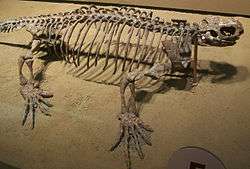Casea
| Casea Temporal range: Early Permian | |
|---|---|
 | |
| C. broilii skeleton in the Field Museum of Natural History | |
| Scientific classification | |
| Kingdom: | Animalia |
| Phylum: | Chordata |
| Clade: | Synapsida |
| Clade: | †Caseasauria |
| Family: | †Caseidae |
| Genus: | †Casea |
| Type species | |
| †Casea broilii Williston, 1910 | |
| Species | |
| |
Casea is an extinct genus of pelycosaur synapsid which was about 1.2 metres (4 ft) long, slightly smaller than the otherwise very similar Caseoides. Casea was one of the first amniote herbivores, sharing its world with animals such as Dimetrodon and Eryops. It was possibly also aquatic.[1]
Description


Casea had a heavy, rotund, body and a small skull. Its rib cage was greatly expanded, presumably to make space for a large, plant-fermening gut as well as proportionally large lungs. Like other caseids, it lacked teeth in its lower jaw, and had blunt teeth in the upper jaw. These adaptations indicate that Casea was a herbivore, feeding on relatively tough plants, such as ferns.[2] Like most derived caseids it had paddle-like limbs and osteoporotic bones, indicating adaptations for an aquatic lifestyle.[3]
See also
References
- ↑ Lambertz, M.; Shelton, C.D.; Spindler, F.; Perry, S.F. (2016). "A caseian point for the evolution of a diaphragm homologue among the earliest synapsids". Annals of the New York Academy of Sciences. doi:10.1111/nyas.13264.
- ↑ Palmer, D., ed. (1999). The Marshall Illustrated Encyclopedia of Dinosaurs and Prehistoric Animals. London: Marshall Editions. p. 188. ISBN 1-84028-152-9.
- ↑ Markus Lambertz et al, A caseian point for the evolution of a diaphragm homologue among the earliest synapsids, Annals of the New York Academy of Sciences (2016). DOI: 10.1111/nyas.13264
